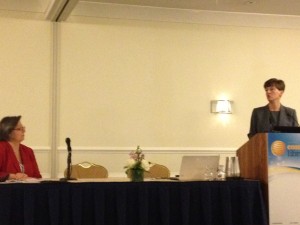 To Flip or Not to Flip, That Is the Dilemma!
To Flip or Not to Flip, That Is the Dilemma!
Kari Arfstrom, Executive Director, Flipped Learning Network
Pat Semple, Upper School Librarian & Academic Center Media Specialist, Bullis School
Prime question is–
What is the best use of your class time? Practice, discussion, guided practice, assessment?
The media portrayal of the flipped classroom needs debunking. Need to move the discussion to a deeper pedagogical discussion. Like VCR’s allowed us to timeshift our television viewing, this allows students to time shift learning.
Flipped learning is when you move from group learning environment to indiv. learning space; and moves to a student-centered env. The most important piece of the flipped classroom is that the teacher is a key piece of the learning. Teacher obviously controls when videos/content is shared w/students–can use during a lesson, introductory to lesson, at end of unit as a reviewing tool, etc. Is used in a variety of content areas (example–P.E. teacher using Flipped learning to introduce sports like this Pickleball video which has gone viral)
Misconceptions:
- Flipped Learning is all about videos.
- Flipped learning creates a digital divide. (Libraries can provide internet access for students, smartphones can be used, etc. Teachers or librarians can give flash drives or dvd to students if needed.)
- Flipped learning propogates bad teaching (lectures). This is a cultural issue regarding the teacher, not the concept.
- Flipped learning is the answer. No, it’s one of many answers.
Resources:
ISTE book- Flip Your Classroom
Site flippedclassroom.org–the FLN Ning includes a section for librarians; also a variety of webinars for teachers in various content areas. They also have a blended learning course on Flipped classrooms.
Pat Semple — Applying this to libraries
As librarians, we spend a lot of time doing some basic instruction, introductions to resources, etc. that takes up our limited time with students. By posting videos of basics of research, databases, library orientations, pathfinders, etc., then you can free up time to spend with classes and talk about more complex issues relating to research when you are actually spending time with them.
Also avoids issue of you having repetitive orientations–where students had heard you speak in a diff content area already.
Pat Semple- Bullis School sample pathfinder
Question from audience–what if students haven’t watched the materials? Kari suggests setting up a screen in room so students could get in a group and watch what they hadn’t seen; hand a group of students the device so they can look over the information and then you can help others in the meantime.
Library is now a place for a “meeting of minds.”
One thought on “Flipping your library: Internet @ Schools”